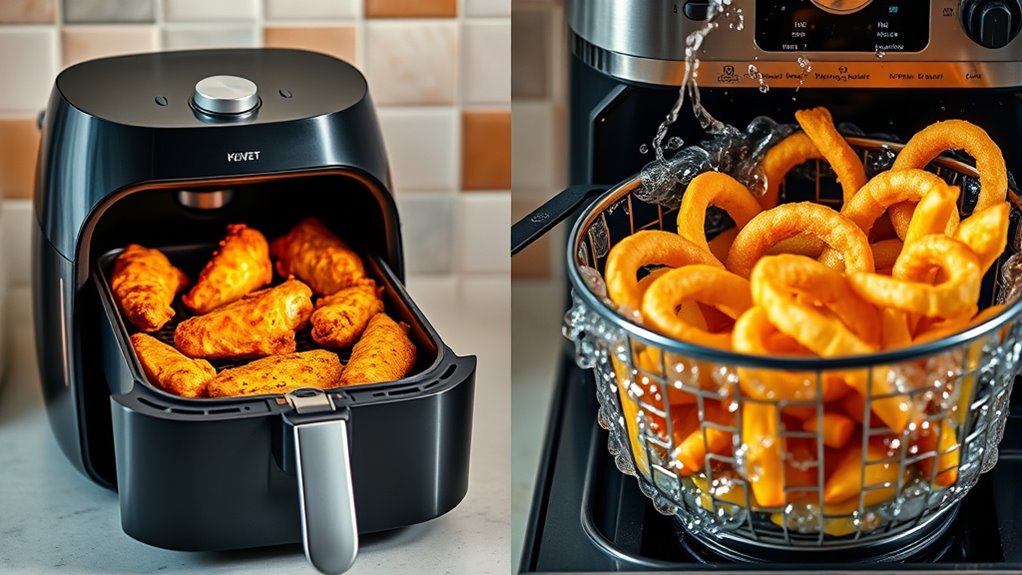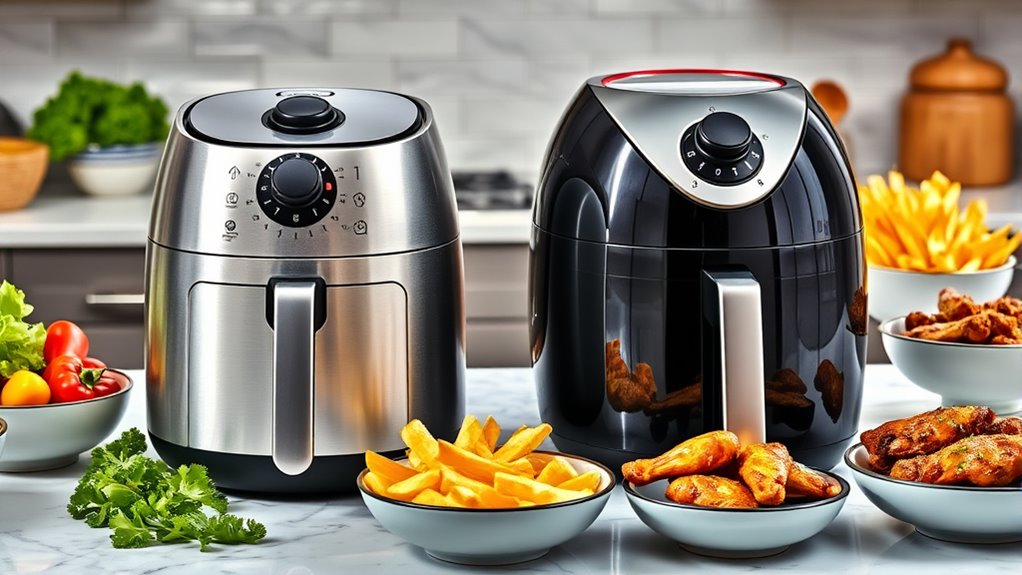In the nutrition comparison, air fryers use much less oil, leading to foods that are lower in calories and healthier fats like trans fats and aldehydes. They also better preserve nutrients and reduce harmful compounds formed during high-temperature cooking, unlike deep fryers which absorb more oil and produce more carcinogens. If you want to understand how each method affects your health and food quality, keep exploring these key differences.
Key Takeaways
- Air fryers use 70-80% less oil, resulting in fewer calories and healthier fat profiles compared to deep fryers.
- Deep frying increases formation of trans fats, aldehydes, and carcinogenic compounds, raising health risks.
- Air frying better preserves water-soluble nutrients and antioxidants due to lower temperatures and reduced oil exposure.
- Foods cooked in air fryers generally contain fewer harmful compounds like acrylamide and AGEs than deep-fried foods.
- Deep frying enhances flavor and crispiness but significantly raises calorie, fat, and chemical hazards, unlike healthier air frying.
How Air Fryers Minimize Oil Use and Its Impact on Nutrition

Air fryers considerably reduce the amount of oil needed to cook your favorite foods, often using less than a tablespoon per serving. This means you’ll consume less fat and calories compared to traditional deep frying. Using less oil in air frying helps improve your nutrition by cutting down on unhealthy fats and harmful compounds like trans fats and acrylamide. With less oil, your meals become healthier, supporting better heart health and weight management. Plus, the small amount of oil needed allows you to choose healthier options such as olive oil, further boosting nutritional benefits. Incorporating healthier cooking methods like air frying can also contribute to a balanced diet and overall wellness.
Calorie Content Comparison Between Air Fried and Deep Fried Foods

Because of the considerable difference in oil absorption, air-fried foods typically contain 70-80% fewer calories than their deep-fried counterparts. This makes a big impact on calorie content and overall health. When comparing air frying vs deep frying, you’ll notice that:
- Air-fried foods have markedly lower food calories due to less oil use.
- Traditional deep fried food can contain double or triple the calories of air-fried options.
- Using less oil in air frying reduces fat and calorie levels, supporting healthier cooking.
- The oil reduction in air frying enhances the health benefits of your meals, helping with weight management.
- Additionally, understanding the contrast ratio of cooking methods can help you better appreciate how different techniques influence the visual appeal of your food.
- Recognizing the nutritional impact of each method can assist in making more informed dietary choices.
- Proper equipment maintenance, such as ensuring the air fryer components are clean and functioning correctly, can optimize your cooking results and preserve nutrient integrity.
- Maintaining the equipment properly can also prevent residual oil buildup, ensuring that your food remains healthier and tastes better.
Fat and Inflammatory Compound Levels in Different Cooking Methods

When you choose between an air fryer and a deep fryer, you’ll notice differences in fat content and harmful compounds. Deep frying often creates higher levels of trans fats and aldehydes, which can increase inflammation. Air frying reduces these risks by using less oil and limiting the formation of inflammatory chemicals. Additionally, ongoing research on AI vulnerabilities highlights the importance of developing robust safety measures to prevent potential risks associated with new technologies. Implementing energy-efficient cooking appliances can further enhance sustainability and reduce environmental impact over time. Moreover, choosing healthier cooking methods aligns with the goal of minimizing pollution and emissions, as lower emissions contribute to a cleaner environment and support the transition to sustainable energy sources. Incorporating eco-friendly appliances can promote responsible consumption and reduce overall ecological footprints. Recognizing the significance of cooking method impacts on health can guide consumers toward more mindful choices.
Fat Content Disparities
Deep frying markedly increases the fat content of foods, with oil absorption adding between 10-25% of the food’s weight, which can substantially raise calorie and fat intake. In contrast, air frying uses less than a tablespoon of oil, limiting added fat to about 14 grams per serving. Moreover, choosing the right cooking method can influence the levels of inflammatory compounds, which play a role in chronic disease development. Consider these key points: 1. Deep frying results in higher fat content due to oil absorption, increasing calorie intake. 2. Oils used in deep frying, especially seed oils, produce trans fats and inflammatory aldehydes when heated. 3. Air frying minimizes inflammatory compounds like oxidized lipids and reduces trans fats formation. 4. The lower fat and inflammatory compound levels in air-fried foods help decrease systemic inflammation and support heart health. 5. Using healthy oils in air frying can further reduce the formation of harmful compounds and promote better health outcomes. Incorporating antioxidant-rich oils such as olive or avocado oil can further mitigate the formation of harmful compounds during air frying. Additionally, selecting proper cooking oils can help minimize the production of inflammatory substances and enhance overall health benefits. The use of advanced filtration technology in air fryers can also help reduce airborne contaminants and odors. Choosing air frying over deep frying can significantly reduce unhealthy fat consumption and inflammation.
Harmful Compound Formation
Cooking methods considerably influence the formation of harmful compounds in your food. Deep frying, with its high-temperature oil degradation, promotes the creation of trans fats, aldehydes, and other inflammatory compounds linked to cardiovascular risks. These conditions also cause oil oxidation, which produces carcinogenic compounds. In contrast, air frying uses less oil and operates at lower temperatures, reducing the formation of acrylamide and advanced glycation end products (AGEs). This results in fewer inflammatory and carcinogenic chemicals in your food. Studies show that deep-fried foods contain aldehydes up to ten times higher than air-fried options. By choosing air frying, you limit the production of harmful compounds caused by high-temperature oxidation, making it a healthier method that minimizes inflammation and carcinogenic risks. Proper cooking techniques can further reduce the formation of these dangerous substances, promoting better health. Additionally, mindful selection of cooking methods aligns with home improvement practices aimed at creating safer and healthier living environments. Incorporating food safety practices, such as maintaining proper oil temperatures and avoiding reuse, can further decrease the formation of these harmful compounds. For example, controlling oil temperature is critical to prevent excessive breakdown and oxidation of fats.
Effects of Cooking on Nutrient Preservation and Food Quality

Cooking methods markedly impact nutrient retention and food quality, and understanding these differences helps you make healthier choices. Air frying generally preserves more nutrients and produces a better texture and flavor than deep frying, which can degrade sensitive nutrients and create undesirable flavors. By choosing the right method, you can enjoy meals that are both delicious and nutrient-rich. Additionally, considering family photoshoot fails can remind us that even unexpected results can lead to memorable and enjoyable experiences.
Using an appropriate cooking technique can also reduce the formation of harmful compounds that sometimes develop during high-temperature cooking processes like deep frying, aligning with celebrity lifestyle insights that highlight the importance of health-conscious choices.
Nutrient Retention Differences
When choosing between air frying and deep frying, understanding how each method affects nutrient retention is essential. Air frying generally preserves more heat-sensitive nutrients like omega-3 fatty acids, antioxidants, and vitamins because it uses lower temperatures and less oil. Deep frying, however, exposes food to higher temperatures, leading to greater thermal degradation and nutrient loss, especially of water-soluble nutrients like vitamin C and B-vitamins. Consider these points:
- Air frying maintains higher levels of delicate nutrients due to less thermal degradation.
- Deep frying can cause significant nutrient loss, particularly water-soluble vitamins.
- Reduced formation of advanced glycation end products (AGEs) in air frying supports better food quality.
- Overall, air frying offers better nutrient preservation, ensuring your food retains more of its original nutritional profile.
- Additionally, the lower oil content in air frying can help prevent the formation of harmful compounds associated with oil-based cooking methods.
Texture and Flavor Impact
Both air frying and deep frying create crispy textures that appeal to your taste buds, but they do so in different ways that influence flavor and nutrient preservation. Air frying produces a crispy exterior with less oil absorption, offering a lighter, less greasy flavor profile while maintaining good nutrient retention. Deep frying also achieves browning and the Maillard reaction, creating rich flavor and a traditional fried taste, but it often introduces more harmful compounds like trans fats and acrylamide due to higher oil temperatures. The texture in both methods is satisfying, but air frying provides a healthier option with less impact on nutrients and fewer chemical byproducts. Overall, each method affects food quality differently, shaping the final flavor and texture you experience.
The Role of Oil Type and Quantity in Nutritional Outcomes

The type and amount of oil used during frying play a crucial role in determining the dish’s nutritional impact. Using more oil, like in deep frying, increases calorie content and fat absorption, raising health concerns. Consider these points:
Choosing less oil or healthier oils during frying improves your dish’s nutritional profile and promotes better health.
- Oil type influences nutritional outcomes; healthy oils like olive oil reduce harmful oxidation products compared to seed oils.
- Oil quantity affects trans fats and acrylamide formation; less oil in air frying minimizes these risks.
- Deep frying with seed oils can produce carcinogenic aldehydes at high temperatures.
- Using less oil in air frying lowers calorie intake, decreases acrylamide, and reduces harmful oxidation products, promoting better health.
Impact on Food Safety and Harmful Substance Formation

Air frying markedly enhances food safety by reducing the formation of harmful substances typically produced during high-temperature cooking. When you deep fry, the intense heat promotes the Maillard reaction, which creates acrylamide and aldehydes—both linked to health risks. Deep frying also releases more trans fats and oxidation products from seed oils, increasing chemical hazards. In contrast, air frying limits these compounds, decreasing the risk of harmful substances forming. It produces less high-temperature browning, which means fewer chemical hazards and safer food. By minimizing oxidation products and harmful aldehydes, air frying offers a safer alternative that reduces potential carcinogenic and inflammatory risks, ultimately improving food safety in your kitchen.
Dietary Benefits and Potential Limitations of Each Method

While deep frying creates irresistibly crispy and flavorful foods, it also substantially increases calorie and fat intake due to the large amounts of oil involved. Air frying offers notable dietary benefits by reducing oil usage by 70-80%, which helps lower calorie intake and fat content. However, some limitations exist:
Deep frying boosts flavor but significantly raises calorie and fat intake; air frying reduces oil for a healthier option.
- Nutritional differences: Fried food may retain more flavor but at the expense of increased health issues related to high oil intake.
- Health risks: Deep frying can lead to trans fat formation, impacting cardiovascular health.
- Food safety: Air frying produces fewer harmful compounds like acrylamide, making it a safer choice.
- Texture trade-offs: While fried food provides a more classic crispy texture, air frying delivers a healthier, lower-fat alternative.
How to Maximize Health Benefits When Using Air Fryers and Deep Fryers

Maximizing health benefits when using air fryers and deep fryers involves mindful choices about ingredients, oil use, and cooking practices. To boost health benefits, opt for minimal oil—using a teaspoon or less—to reduce calories and fat. Choose healthier oils like olive or avocado over seed oils to lower harmful aldehyde emissions. Select minimally processed foods to preserve nutrients and avoid added sugars or preservatives. Limit frying time and avoid excessively high temperatures to decrease acrylamide formation and other harmful compounds. Regularly clean your appliances and dispose of used oil properly to maintain food safety and prevent chemical degradation. By making these adjustments, you can enjoy crispy dishes with fewer health risks, maximizing the nutritional value of your favorite fried foods whether using an air or deep fryer.
Practical Tips for Incorporating These Appliances Into a Balanced Diet

Incorporating air fryers and deep fryers into a balanced diet requires thoughtful planning to guarantee you’re enjoying crispy favorites without compromising your health. Here are some practical tips:
- Use air frying for vegetables and lean proteins to boost nutrient intake and reduce unhealthy fats.
- Limit deep-fried foods to occasional treats, minimizing trans fats and excess calories.
- Choose healthy oils like olive or avocado oil sparingly when air frying to enhance flavor and health benefits.
- Balance fried foods with fresh fruits, salads, and whole grains, and follow proper cleaning and maintenance for appliance safety.
Frequently Asked Questions
Which Is Healthier, an Air Fryer or a Deep Fryer?
You’re asking which cooking method is healthier. An air fryer is the better choice because it uses little to no oil, markedly lowering your fat and calorie intake. It also produces fewer harmful compounds like acrylamide and trans fats compared to deep frying. By choosing an air fryer, you’re making a smarter, healthier move for your diet, reducing risks associated with high-fat, fried foods while still enjoying crispy, tasty meals.
Does Air Frying Reduce Nutritional Value?
Think of your nutrition as a delicate garden—you want to protect every bloom. When you air fry, you reduce oil absorption, keeping nutrients intact and lowering calorie intake. While some vitamins may fade at high temps, overall, air frying preserves most nutrients, much like gentle watering. So, yes, air frying minimally reduces nutritional value, making your meals healthier without sacrificing flavor or essential nutrients.
What Is the Calorie Difference Between Deep Frying and Air Frying?
You wonder about the calorie difference between deep frying and air frying. When you deep fry, foods absorb lots of oil, adding around 800-900 calories per batch, and a typical serving could have 200-300 extra calories. In contrast, air frying uses minimal oil, often less than a tablespoon, reducing calories by up to 80%. Overall, air frying helps you cut hundreds of calories per serving, making meals healthier and easier to manage.
What Is the Downside of the Air Fryer?
You might find that the air fryer has some downsides. It can produce higher levels of acrylamide than traditional frying, which is a concern. It may also change the taste and texture of foods, making them less authentic and satisfying. Additionally, some models have limited capacity, so cooking large batches is tough. You might also notice that certain foods don’t get as crispy as deep frying, especially heavily battered items.
Conclusion
Choosing between an air fryer and a deep fryer is like selecting a gentle breeze or a stormy gust—both have their place. While air fryers offer a lighter, more nutritious option by reducing oil, deep fryers can deliver richer flavors with careful use. Ultimately, balancing your choices and mindful use can turn your kitchen into a garden of health rather than a battlefield, helping you enjoy your favorite foods without sacrificing your well-being.









